Land Registrations
In some cases, land registrations in the Barcaldine district in the 1870s were renewals of earlier registrations.
The government passed a new land act in 1884, under which all blocks were to be properly surveyed and leases consolidated into registered holdings on which payment of rent could be enforced. Under its provisions each large property lost a portion, resumed for closer settlement. The work took time and in the Barcaldine area, consolidation coincided with the birth of the town – 1886.
Land sales
The first sale of Barcaldine town lots was held at Jericho on December 22, 1885, for a site in the property of Foxhall where a telegraph line from Blackall to Aramac (constructed in 1879) crossed the proposed route of the railway. The line was planned to extend 12 miles further west and for a time there was indecision about which position would be the terminus township, so authorities arranged that lots could be exchanged for others of equal value if the second site were chosen. Many people were willing to speculate an upset price of £2 for a vacant block. Altogether, 60 lots were sold with highest prices paid by Tobin – £100, and Shakspeare – £66, although both were forfeited later. George Shakspeare (spelling was changed to Shakespeare in time) was a well known racing man and hotelier whose name has been adopted for the main street in Alpha and whose Shakspeare Hotel in Barcaldine was famous in Central Queensland for decades. At the second sale of town land held in Jericho on August 31, 1886, there was even keener demand with prices up to £277 and the upset price for a half-acre lot risen to £5.
Good water below the ground was proven but cost of bringing it to the surface was beyond the would-be settlers. The government pursued a generous policy of land development, throwing open blocks of all sizes but they were not often taken up. Mr. A. Moody of Queensland National Bank wrote in December 1887 that five grazing areas of 9,000 to 13,000 acres from Barcaldine Downs were available but added, ‘I have not heard any enquiries concerning them’. He also commented on 55 smaller areas on Home Creek and the Alice River. For these only four applications had been received. A property called Tara was formed from resumptions of Barcaldine Downs, Saltern and Wellshot and taken up by the Cudmore family. Lands Department records show that a lease for Tara was issued to Milo Robert Cudmore from July 1, 1890 although The History of Queensland names James Kenneth Cudmore as the man who took it up in 1899.
In July 1887 carriers asked that land be thrown open in the vicinity of the town where they might graze their stock in waiting periods. In response, a survey known as Foxhall Village Settlement was made along the course of Lagoon Creek. A newspaper reported that:
none will take up the Foxhall Village Settlements owing to lack of water. Twenty-two bonafide selectors guaranteed to take up allotments upon the government undertaking to put down a bore in the village ... but the Lands Department couldn't see it.
Capricornian, June 1889
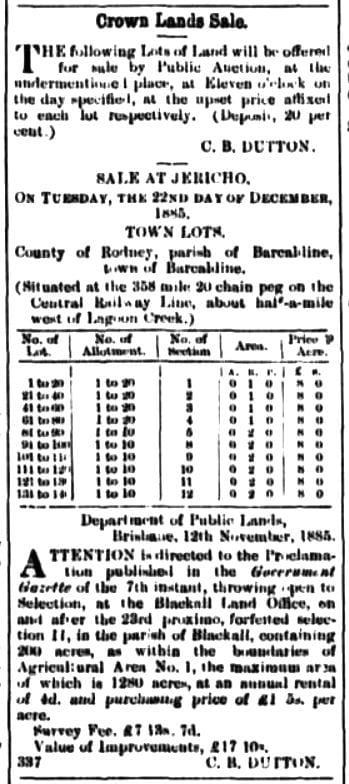
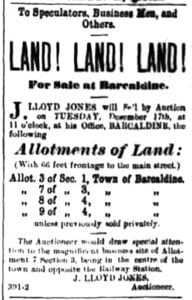

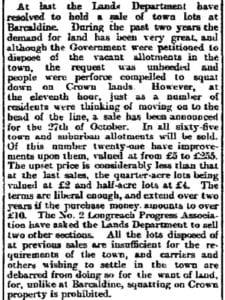
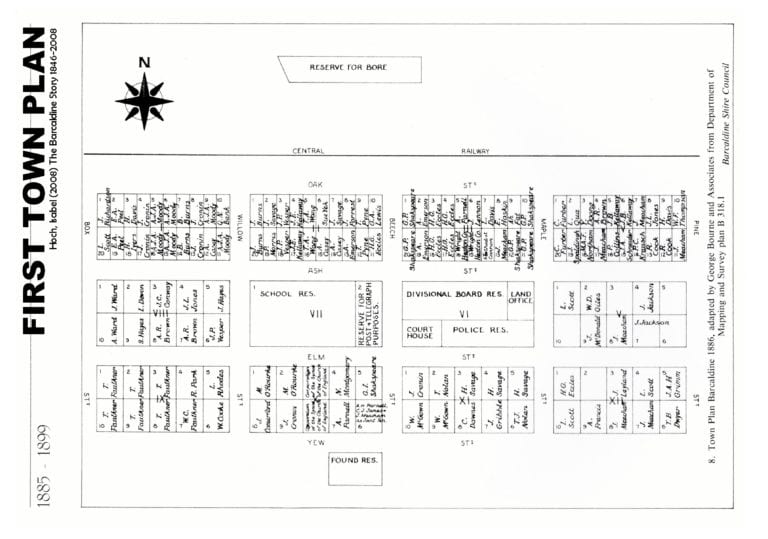
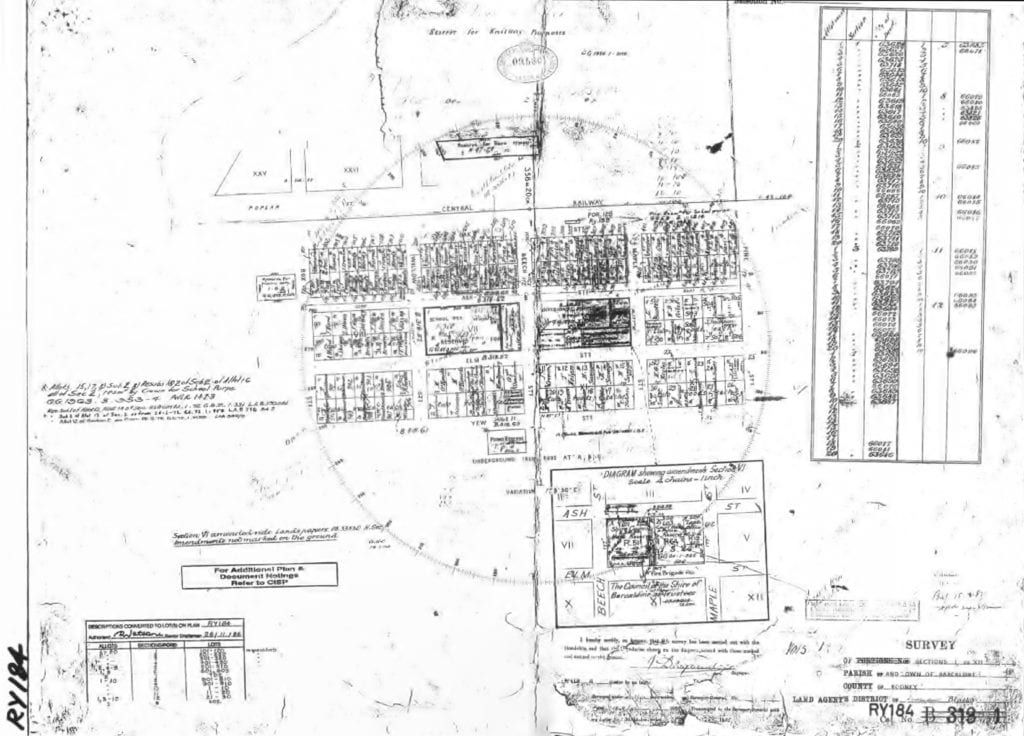
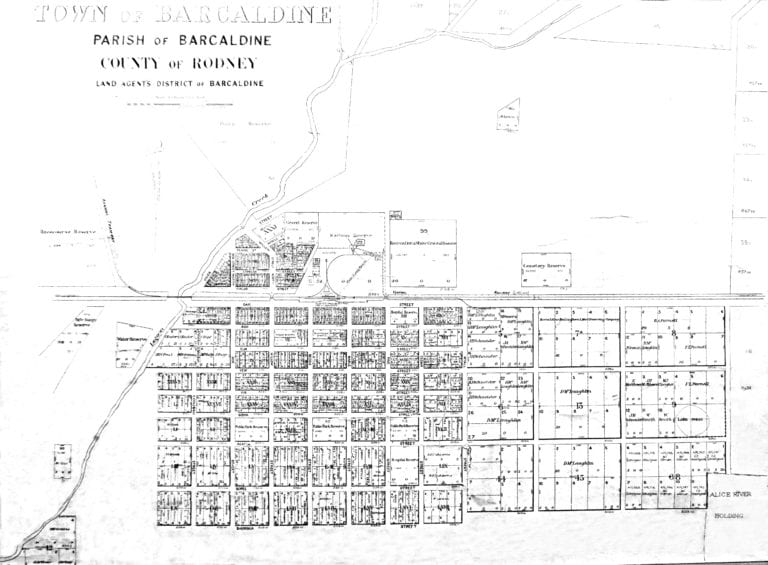
Resumption Ballots
New opportunity came for settlers who drew blocks of Saltern Creek and Coreena land after drought ended and while cost of stocking was low. Resumption of these properties had been awaited eagerly for years.
Despite the problems of country life, supply of land for selection was never equal to the demand. Sheep numbers built up in the good seasons and by 1911 were back to pre-drought (1898) levels, Value of greasy wool rose by wartime demand to over 16d a pound and after a short drop about 1920-21 rose again to over 25d a pound in 1925. It is not surprising that when resumptions came up for ballot, applications poured in.
Home Creek Ballot
While blocks from Delta offered by tender drew 16 applicants in 1908, there were 892 hopeful applicants for five portions of Home Creek in 1914. At a public ballot in November at Barcaldine Land Court each stepped forward in turn to draw a slip of paper from a box.
P. Manning, T.J. Chisholm, J.E. Allason, J. Campbell and W. Ellem drew the ones marked ‘accepted’.
Saltern Creek Ballot
A large crowd gathered at the Barcaldine Land Court for the ballot of the twelve Saltern Creek blocks on June 6, 1928, under supervision of the district Land Commissioner, J. E. Arnold. For the first time numbered marbles were used to decide 12 winners from 615 applicants including 35 from other states.
Marbles were drawn for: A. Anderson C. Loft E. Crotty A. Frazer Cominos and Cominos R. Nason L. Noonan and P. Noonan O. Hill W. Fraser R. Anderson R. Johnstone J. Halferty.
Shortly before the ballot a final tennis party was hosted at Saltern Creek by manager W. F. Riley and his wife. Tennis tournaments between country teams had been annual events there since 1923. Eight properties took part in the 1928 match won by Moyse and Moyse of Dunraven.
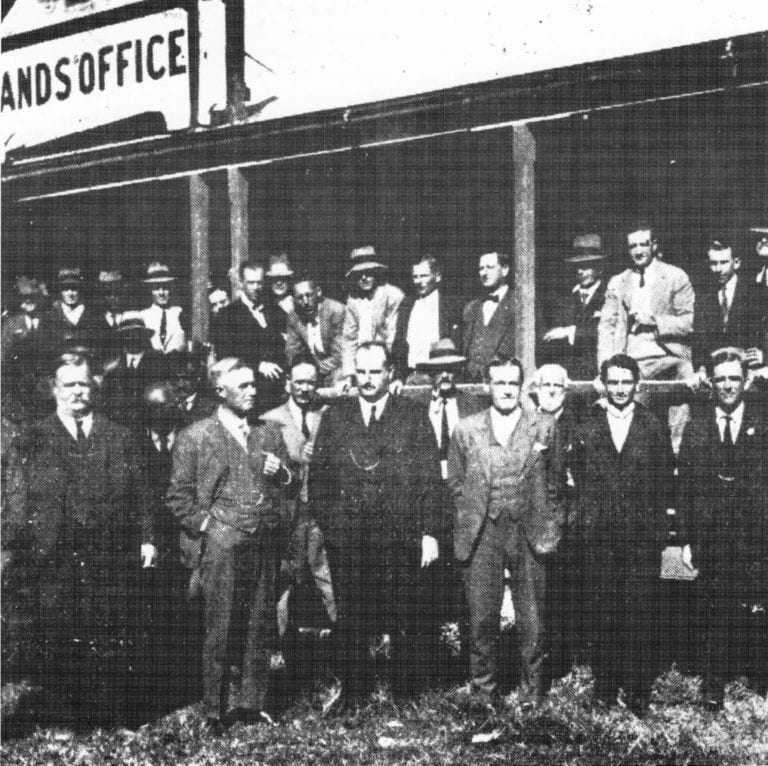
Coreena Ballot
The Coreena Ballot was held on September 7, 1929. Although the property was in Aramac Shire, it was so close geographically in Barcaldine that it has always been an integral part of the district. Taken up by Rule and Lacy in the 1860s, Coreena passed to Milsone and De Satge in 1874 and then to Coreena Pastoral Cp. in June 1881. Pasrtners were W. C. Little, Dr. Syme of Melbourne, Sir George Fairbairn and Donald Wallace (owner of the racehorse, Carbine). The company bought Lochnagar and W. C. Little supervised the whole area for a time before moving to Rockhampton as manager of Union Mortgage Co. McMaster, King and Begg were successive managers of Coreena before W. C. Miller took over in 1897. After resumption, Coreena Pastoral Co. retained only 44,000 acres and in 1930 this area was made available to Miller on easy terms on condition that he oversaw management of other properties held by the company. His son, Cecil Miller succeeded him and still lived in Coreena in 1985.
In the 1929 ballot seven Coreena blocks were won from over 500 applicants by C. Kemp H. Shakespeare J. Keeshan K. McKenzie D. Stibbards J. Hosburg G. Hosier.
Prior to the ballot, 52,580 sheep of Coreena’s stud flock were sold at auction. It was believed to be one of Australia’s largest sales of a single ear mark. On June 1915, 1929, the average price for these ewes was £10.0.10, while rams brought £11.2.6 and £8.8.0 on a falling market.
By 1930 eight of the new selectors of Saltern and Coreena were reported to have built homes and all had stocked with sheep but wool prices continued a downward plunge until the cost of production could not be met. Before the first World War 9d to 10d a pound for greasy fleece brought a reasonable return but 20 years later, taxation, higher rates and union demands had overtaken profit.
Text sources include: Hoch, Isabel (1986)
